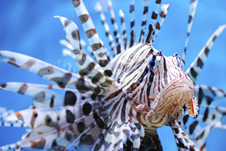3Qs: Lionfish roar into tropical waters

Invasive species can wreak havoc on ecosystems, like the Atlantic Ocean off the Southeastern U.S. and the Caribbean. Researchers have struggled in recent years to combat the presence of lionfish — which are native to the Indo-Pacific waters. Annette Govindarajan, an instructor in Northeastern University’s Department of Earth and Environmental Sciences, explores the dangers that this fish and other invasive species present.
Why are lionfish a threat in the Atlantic Ocean, and what are some solutions to curbing their impact?
They are voracious predators, and they eat a lot of native fish, many of which are important to commercial fishing and the health of coral reefs. The population of lionfish is exploding, but few other fish eat them because of their venomous spines. They are a warm water species and will continue to expand in the tropical Atlantic waters. One solution being heavily promoted is for more people to eat them. The venomous parts are the spines, so if removed, the flesh is fine to eat.
Scientists have also used genetics to discover there are actually two different lionfish species that have come to the Atlantic, though one species is in a clear majority.
What are other examples of invasive species taking hold outside their natural aquatic habitats?
One example is zebra mussels, which were discovered in the Great Lakes for the first time in 1988, and probably got there through the shipping industry in ballast water — water taken from ports to maintain a ship’s stability and released at the destination. If species in ballast water survive the trip and get established, they can proliferate. In the case of the zebra mussel, they grow quickly, and can displace native species and clog up water intake pipes for power plants. Another example is comb jellyfish, which are native to the Atlantic but have taken off in the Black Sea.
Your research focuses primarily on jellyfish. What is one area you hope to explore next?
A big concern out there involves an increasing number of large jellyfish blooms, and one cause is overfishing. Jellyfish can also interfere with fisheries by feeding on fish eggs and larvae, which could slow the growth of fish populations. Some areas of concern with blooms are the Black Sea, the Gulf of Mexico, the Namibian coast of Africa and the Bering Sea. They also live in degraded habitats where oxygen levels are too low for other species.





